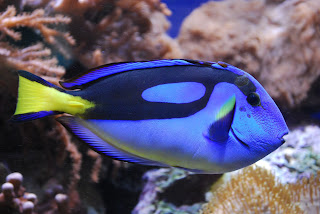Marine Creature of the Month Oct'19
Marine Creature of the Month
Famous Fish: Dory
 |
| Photo from Wikipedia |
Kingdom: Animalia
Class: Actinopterygii
Conservation Status: Least Concern (LE)
WHAT IS DORY?
Dory, from Finding Dory, is commonly known as a Regal Blue Tang. She is a surgeonfish, indigenous to the Indo-Pacific ocean. They are flat fish, with a circular shaped body that ends in a pointed snout, the average adult blue tang growing to 30cm (12in). They have the distinct blue and black colouring, with more yellows coming through in the central Indian ocean populations.
With their home being in the Indo-Pacific ocean, blue tangs are found in reefs around many countries, such as Japan, Indonesia, and the Great Barrier Reef around Australia. They are a common and abundant fish in these areas. They live in either pairs or small groups between eight and fourteen. The males are generally bigger than the females, on average an adult blue tang weighs only 600g (21oz).
 |
| Photo from Live Science |
WHAT IS DORY'S LIFE LIKE?
Regal Blue Tangs start life as microscopic, translucent larvae. As eggs they float in clouds with millions of others in deep waters, a drop of oil to aid in their flotation. After twenty four hours they hatch into larvae and then they grow. It takes between nine to twelve months for them to reach maturity, presumably their adult size, so they grow rather quickly. The males aggressively "court" the females which results in a speedy upward spawning. They spawn near the surface of the water, during the late afternoon or early evening.
As juveniles, they eat plankton exclusively. The adults have a more varied palate, for they eat algae as well as plankton. In this respect, blue tangs are vital to reef life, for they keep the algae populations down which would otherwise choke the corals.
 |
| Photo from Animal World |
WHAT THREATENS DORY?
Regal Blue Tangs remain largely unthreatened. They have a distinct smell and are dangerous for humans to consume, which keeps them off fisheries lists except to use as bait. However, thanks to the popularity of Dory, they are being over fished for aquariums and home use which, honestly, did you even watch Finding Nemo? Very much against this practise, as they spend the whole film trying to reunite father and son! But that's another rant for another day.
The biggest threat to blue tangs is environmental. As we continue to pollute our oceans, coral reefs are dying. Whether they are bleached or choked by over fertilised algae, coral reefs are decreasing in size. This is where blue tangs live. No reef, no tang. Simple as.
 |
| Photo from Mental Floss |
FUN FACTS
- There is another reason blue tangs are not heavily fished, and that's their built in defence system. Their caudal fin (tail fin) has spines which protrude when excited. When the fish thrashes, anyone handling them are at risk of being cut by the spines in their caudal fin.
- This not only produces deep cuts, but can also cause swelling and discolouration.
- These spines are from where they get the name, surgeonfish.
- It is believed that some species have venom glands.
- Blue tangs cause ciguatera poisoning if consumed by people.
- Juveniles are more yellow than blue, with only around their eyes being blue. They get bluer as they get older.
- They will "play dead" when faced with a predator by lying on their side and very still.
Did you like finding Dory? (Geddit?!) Who is your favourite famous fish? Lemme know below!
Listening to: This is WALK THE MOON



Comments
Post a Comment